We can’t say for certain that Andrew Freedman wouldn’t be clueless without his CO2 paranoia, but it almost certainly has made his condition worse. He rants about Sandy without checking his facts.
Scientists cannot yet answer the specific question of whether climate change made Hurricane Sandy more likely to occur, since such studies, known as detection and attribution research, take many months to complete. What is already clear, however, is that climate change very likely made Sandy’s impacts worse than they otherwise would have been.
There are three different ways climate change might have influenced Sandy: through the effects of sea level rise; through abnormally warm sea surface temperatures; and possibly through an unusual weather pattern that some scientists think bore the fingerprint of rapidly disappearing Arctic sea ice.
The most damaging aspect of the storm was the massive storm surge that struck the coastline from Massachusetts to Maryland. Global warming-related sea level rise gave the surge a higher launching pad than it would have had a century ago, making it more damaging than it otherwise would have been. This is only going to get worse as sea level rise continues as a result of warming ocean waters and melting polar ice caps and glaciers.
The storm surge at The Battery in Lower Manhattan was the highest ever recorded at that location. It surpassed even the most pessimistic forecasts, with the maximum water level reaching 13.88 feet above the average of the daily lowest low tide of the month, known as Mean Lower Low Water, including a storm surge component of 9.23 feet. That broke the official record of 10.5 feet above Mean Lower Low Water set in 1960 during Hurricane Donna, as well as a record set during a hurricane in 1821.
How Global Warming Made Hurricane Sandy Worse | Climate Central
Manhattan has been steadily subsiding for thousands of years due to post glacial rebound. Tide gauge records show no global warming footprint.
 Data and Station Information for NEW YORK ( THE BATTERY)
Data and Station Information for NEW YORK ( THE BATTERY)
The 1821 storm which he casually mentions was nearly identical to Sandy, and actually split Manhattan into two islands – despite the fact that the island was nearly two feet higher in 1821 as it is now. It came from a category four hurricane.
Sandy’s storm surge was largely driven by the fact that it was a full moon high tide, which raised tides almost a foot higher than the date of the 1821 storm.
As far as sea surface temperatures go, there is no indication that global warming had anything to do with it. Sandy hit an anomalously warm spot, but sea surface temperatures over much of the globe are anomalously cold. Freedman is using water temperature off New Jersey as a proxy for the planet, putting him on a par with one-tree Briffa for scientific malfeasance.
Sandy was largely powered by unusually cold inland temperatures. There is absolutely no reason to believe that global warming either caused or exacerbated Sandy’s storm surge.
Freedman has no idea what he is talking about.



I explained this over at DotEarth a few days ago.
“Arno, it is obvious to the most casual climateer that hurricane Sandy is absolutely caused by your carbon footprint. The cobbled connections from Satan’s cobbles are screaming at you.
Research may have shown that blocking patterns have increased in frequency and intensity in recent years, particularly when global warming has stalled. Some activists think that these likely spurious trends may be related to the loss of sea ice as a result of an Arctic storm. This year’s sea ice minimum, the lowest since 1979, opened large expanses of open water, which absorbs more incoming solar radiation at a time of year when solar radiation is feeble and plummeting. The rapid refreeze due to higher radiative and convective heat loss from open water adds more or less heat and more or less moisture to the atmosphere, which may alter weather patterns somewhere on the globe through teleconnections. Exactly how the patterns changed from pre-SUV days is unknown, and the data does not exist, so we need more research money.
Hope that clears it up.”
He has a Masters in ‘Climate and Society’ and is a journalist. That’s enough for me to discount anything he says as even remotely related to reality.
He should be asking himself why Donna, as a Cat 2 when it passed NYC, produced less of a storm surge than post-tropical cyclone Sandy.
Seriously, is the Black Sea now a spa, or what?
0.8 degrees C over 150 years has a lot to answer for – AND – what about the destruction caused by the 4 in 10,000 ?
The Spartans probably would have won if their warriors were as powerful as the 4 !!
I don’t understand this statement: “Manhattan has been steadily subsiding for thousands of years due to post glacial rebound.” I thought “rebound” in this context meant the ground is rising without the enormous weight of glaciers. How can the ground be subsiding?
When the ground goes up in one place, it has to go down somewhere else. It is rising in Canada (where the glaciers were) and falling in the NE US
In a lot of ways, Sandy was a perfect storm, even with respect to a little dab of warm water and its highly unusual race to shore from the Gulf Stream.